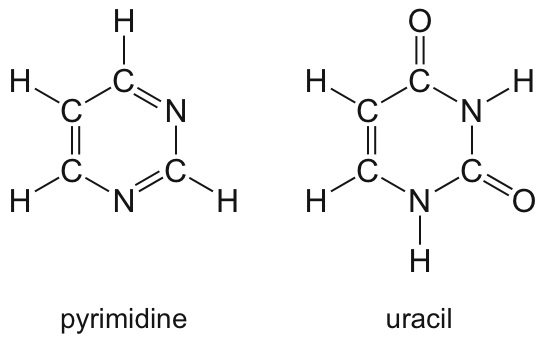NASA scientists, examining the origin of life, succeeded in reproducing the substance uracil, a key component of our hereditary material, in the laboratory. They discovered that when exposed to ultraviolet radiation and under space-like conditions, an ice sample containing the substance pyrimidine produces this essential component of life.

pyrimidine (The entry in Wikipedia) is a ring compound consisting of carbon and nitrogen atoms and is the basic structure of uracil, part of the genetic code found in DNA; R.N.A. It is essential for protein synthesis, and in addition it has many other functions.
"We demonstrated, for the first time ever, that it is possible to get Uracil (The entry in Wikipedia), a component of N.A., in a non-biological manner in the laboratory under the conditions prevailing in space," said Michel Nuevo, at the NASA Research Center. "We show that these laboratory processes, which mimic what happens in outer space, are able to produce basic building blocks used by living things on Earth." The findings of the new study were published in the scientific journal Astrobiology.
NASA scientists have been engaged in simulating the environment that exists in interstellar space and that outside the solar system for many years. During this period they studied a family of high-carbon compounds called polycyclic aromatic hydrocarbons (PAHs) which were identified in meteorites and are the most common high-carbon compounds in the universe. These materials are usually structures of rings with six carbon atoms that resemble compressed hexagons, like a piece of barbed wire.
The substance pyrimidine is also found in meteorites, although scientists still do not know its exact origin. The source could be similar to that of the PAHs, which are probably formed in the final explosion of dying red giant stars, or in the center of compressed clouds of interstellar gas and dust.
"Molecules like pyrimidine have a nitrogen atom in their ring structure, which makes them more sensitive. As less stable particles, they are more susceptible to being discharged by radiation, compared to their counterparts that lack the nitrogen atom," says one of the researchers at NASA. "We wanted to test whether pyrimidine is able to survive in space, and whether it is able to undergo reactions that will transform it into a more complex organic form, such as the nitrogenous base uracil."
The researchers' theory claimed that if indeed the pyrimidine substance is able to survive long enough to move into the dust clouds, they would be able to protect it from radioactive decay. From the moment they are inside the clouds, most of the mules freeze into dust grains (similar to the cases where moisture from the mouth condenses on a cold window in winter).
These clouds are dense enough to eliminate most of the radiation that surrounds them, which originates from space, and thus they provide protection to the furs that are inside them.
The scientists tested their theory, and during their experiments they exposed a pyrimidine-containing ice sample to ultraviolet radiation under space-like conditions, including very high vacuum, extremely low temperatures, and lots of radiation.
They found that when a pyrimidine freezes inside a water glacier it is less vulnerable to being released by radiation. Instead of disintegrating, most of the cells under these conditions are converted into new forms, including the RNA component. Uracil, found in the hereditary material of all living creatures on earth.
"We are trying to understand the mechanisms in space that create this type of separation. Considering the results of our laboratory experiments, the chemistry of exposing ice to ultraviolet radiation may be an important connecting step between what happened in space and the materials that reached the Earth at the beginning of its development," explains one of the researchers.
"No one really understands how life began on Earth. Our experiments demonstrate that from the time our star was formed, many of the building blocks of life were probably already present from its inception. "Since we are simulating general astrophysical conditions, this probably happened wherever stars were formed," the researchers explain.

2 תגובות
These building blocks are not new. Discovering the origin of life is the news!
If the building blocks of life are not unique to Earth, could this increase the probability that life was created on other planets as well?